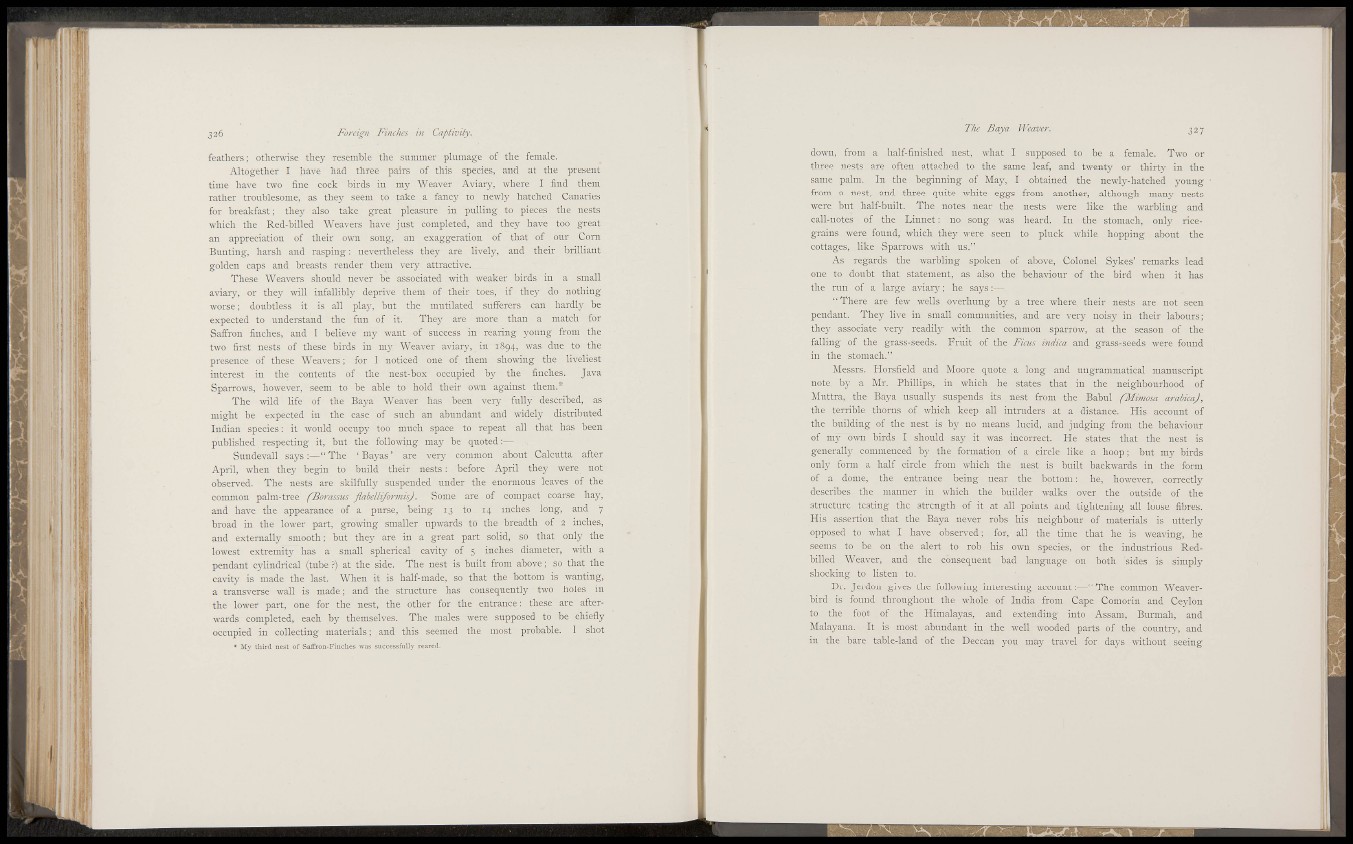
Nt
i
í!
i
i íi •
1. • "i;!! •
•i ¡jlj]
' v i 1
: ••(•!
Fofcign Finchcs. in Captivity.
feathers; otherwise they resemble the simimer plumage of the female.
Altogether I have had three pairs of this species, and at the present
time have two fine cock birds in my AVeaver Aviary, where I find them
rather troublesome, as they seem to take a fancy to newly hatched Canaries
for breakfast; they also take great pleasure in pulling to pieces the nests
which the Red-billed Weavers have jtist completed, and they have too great
an appreciation of their own song, an exaggeration of that of our Com
Bunting, harsh and rasping: nevertheless they are lively, and their brilliant
golden caps and breasts render them verj' attractive.
These Weavers should never be associated with weaker birds in a small
a\aary, or they will infallibl)- deprive them of their toes, if they do nothing
worse; doubtless it is all play, but the mutilated sufferers can hardly be
expected to understand the fun of it. They are more than a match for
Saffron finches, and I believe mj' want of success in rearing young from the
two first nests of these birds in my Weaver aviary, in 1894, was dne to the
presence of these Weavers; for 1 noticed one of them showing the liveliest
interest in the contents of the nest-box occupied by the finches. Java
Sparrows, however, seem to be able to hold their own against them.*
The wild life of the Baya Weaver has been very fully described, as
might be expected in the case of such an abtindant and widely distributed
Indian species; it wonld occupy too much space to repeat all that has been
published respecting it, but the following may be quoted:—
Sundevall says: "The ' Baj 'as' are very common about Calcutta after
April, when they begin to build their nests : before April they were not
observed. The nests are skilfully suspended under the enormous leaves of the
common palm-tree fBorassiis flabelliformisj. Some are of compact coarse hay,
and have the appearance of a purse, being 13 to 14 inches long, and 7
broad in the lower part, growing smaller upwards to the breadth of 2 inches,
and externally smooth; but they are in a great part solid, so that only the
lowest extremity has a small spherical cavity of 5 inches diameter, with a
pendant cylindrical (tube ?) at the side. The nest is built from above; so that the
cavity is made the last. When it is half-made, so that the bottom is wanting,
a transverse wall is made; and the structure has consequently two holes in
the lower part, one for the nest, the other for the entrance: these are afterwards
completed, each by themselves. The males were supposed to be chiefly
occupied in collecting materials; and this seemed the most probable. I shot
* My third uest of Saffron-Fiuclies was successful!}- reared.
The Baya IVeaver. 327
down, from a half-finished nest, what I supposed to be a female. Two or
three nests are often attached to the same leaf, and twenty or thirty in the
same palm. In the beginning of May, I obtained the newly-hatched young
from a nest, and three quite white eggs from another, although many nests
were but half-built. The notes near the nests were like the warbling and
call-notes of the Linnet : no song was heard. In the stomach, only ricegrains
were found, which they ^yere seen to pluck while hopping about the
cottages, like Sparrows with us."
As regards the warbling spoken of above. Colonel Sykes' remarks lead
one to doubt that statement, as also the behaviour of the bird when it has
the run of a large aviary-; he says:—
" T h e r e are few wells overhung b)' a tree where their nests are not seen
pendant. Thej' live in small communities, and are very noisy in their labours;
the}^ associate very readil)- with the common sparrow, at the season of the
falling of the grass-seeds. Fruit of the Fiats indica and grass-seeds were found
in the stomach."
Messrs. Horsfield and Moore quote a long and ungrammatical manttscript
note by a Mr. Phillips, in which he states that in the neighbourhood of
Muttra, the Baya usually suspends its nest from the Babul fMiviosa arabicaj,
the terrible thorns of which keep all intruders at a distance. His accoitnt of
the building of the nest is by no means lucid, and judging from the behaviour
of ni}' own birds I should say it was incorrect. He states that the nest is
generally' commenced by the formation of a circle like a hoop; but my birds
only form a half circle from which the nest is built backwards in the form
of a dome, the entrance being near the bottom: he, however, correctly
describes the manner in which the builder walks over the outside of the
structure testing the strength of it at all points and tightening all loose fibres.
His assertion that the Baya never robs his neighbour of materials is utterly
opposed to what I have obser^'-ed; for, all the time that he is weaving, he
seems to be on the alert to rob his own species, or the industrious Redbilled
Weaver, and the consequent bad language on both sides is simply
shocking to listen to.
Dr. Jerdon gives the following interesting account:—"The common Weaverbird
is found throughout the whole of India from Cape Comorin and Ceylou
to the foot of the Himalayas, and extending into Assam, Burmah, and
Mala3'ana. It is most abundant in the well wooded parts of the country', and
in the bare table-land of the Deecan you may travel for days without seeing
i'ié